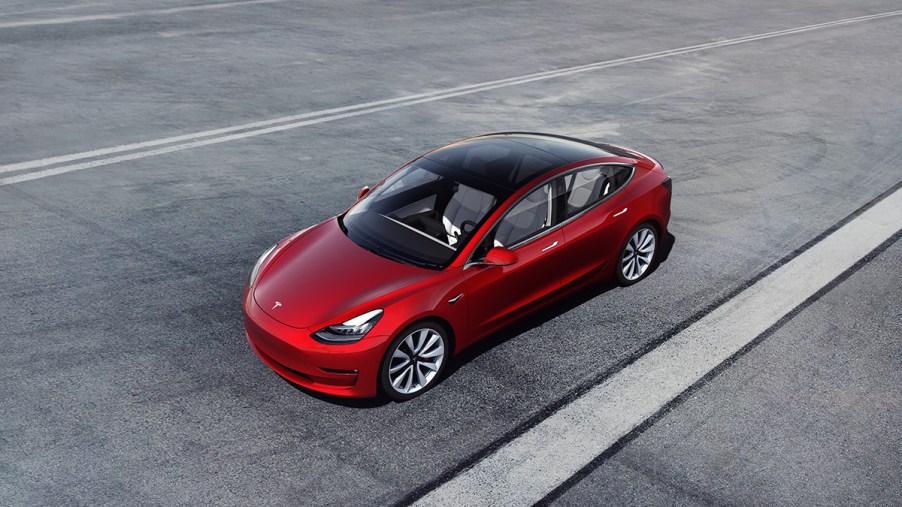
Watch the Tesla Model 3 Drag Race the M3, C63, and Giulia Quadrifoglio
Each vehicle has been optimized for different forms of performance, despite being comparable by vehicle class. Ranging from just over 400 horsepower to over 500, this line up of sporty sedans all face off with the Tesla in a Top Gear test for piston-powered dominance. It is important to note that the Alfa Romeo Giulia Quadrifoglio does not have automatic launch control and that the BMW M3 and C63S have been known to break traction with launch control on, as displayed in a video further into the post.
Musk has boasted that the Model 3 will win out over any comparable vehicle on the track. This video by Top Gear has shown that the Mercedes AMG C63S disproves that claim in a half-mile drag race.
Model 3 (Performance): King Of The Red Light
Powered by dual electric motors that produce a combined 450 hp and 471 lb-ft of torque, the Model 3 is the only AWD vehicle in this race. Musk has boasted that the Model 3 will “beat anything in its class on the track.” Handling for the Model 3 is, purportedly, superior to the M3, but few if any comparisons have been made for the C63S and Giulia QV.
Rolling off the line, there is zero competition for the Model 3 among these sedans. Electric-driven all-wheel drive places Tesla vehicles, including the Model 3, in a class of their own for the price.
BMW M3: Track Performance For The Streets
The BMW M3, a “street-legal race car” complete with M-lap timer and M carbon brakes. Weighing in at around 3,505 lbs, the Bimmer falls dead-center of the three Model 3 competitors in terms of weight. A 3.0-liter twin-turbo inline-six-cylinder power plant throws down 425 hp and 406 lb-ft of torque, making it the weakest car in the list.
C63S: A German-Engineered Ass-Kicking Machine
The Mercedes AMG C63 achieves next-level performance by placing the twin turbos inside the “v” of the engine, minimizing potential areas for pressure loss or turbo lag. The C63 was the only vehicle to overtake the Model 3, doing so just nose-to-bumper at the last second.
Despite the fact that, historically, piston-powered cars have outpaced EVs around 100 miles per hour, the C63S only began to catch up and overtake the Model 3 at over 120 miles per hour. These two vehicles left the M3 and Giulia behind handily.
The 4.0-liter V8 which drives these two turbos can spools them up to 180,000 RPM while maintaining core engine speeds under 8,000 RPM. When you put these parts together, the C63S lays over 500 hp and lb-ft of torque, making it the most powerful car in our line-up.
Giulia Quadrifoglio: If You Can Dream It, You Can Do It
Driven by an “Inspired by Ferrari” V6, the Giulia QV pulls in more horsepower than the V8 C63S, even if it lags behind in torque. Speaking of lag, former Ferrari engineer Philippe Krief helped engineer the V6 power plant and turbo system for minimal turbo lag. The QV falls behind the C63S 0-to-60 time by just 0.1 seconds. The Giulia QV is helping forge a new dynasty of Alfa cars—historically, Alfa could not hold their own with medium-end track cars from the likes of AMG Mercedes and BMW.
When compared in rolling (30mph start) and quarter-mile drag races against just the M3 (Comp) and C63S, the Alfa QV won handily—this directly contradicts the outcome of the Top Gear test, wherein the C63S and Model 3 remained in the lead for the entire half-mile. It is worth mentioning that The QV is more than 600 lbs lighter than the C63S, allowing it to accelerate, brake, and handle better than the Mercedes.
The 2.9-liter twin-turbo V6 pumps out 505 hp and 443 lb-ft of torque, placing it square in the center of our line-up, though it is still the lightest vehicle among these four, allowing it to perform in ways others cannot.
At the end of the day, Mercedes AMG claimed the checkered flag from Tesla in a very, very close half-mile race, while Alfa Romeo and BMW were left behind.


